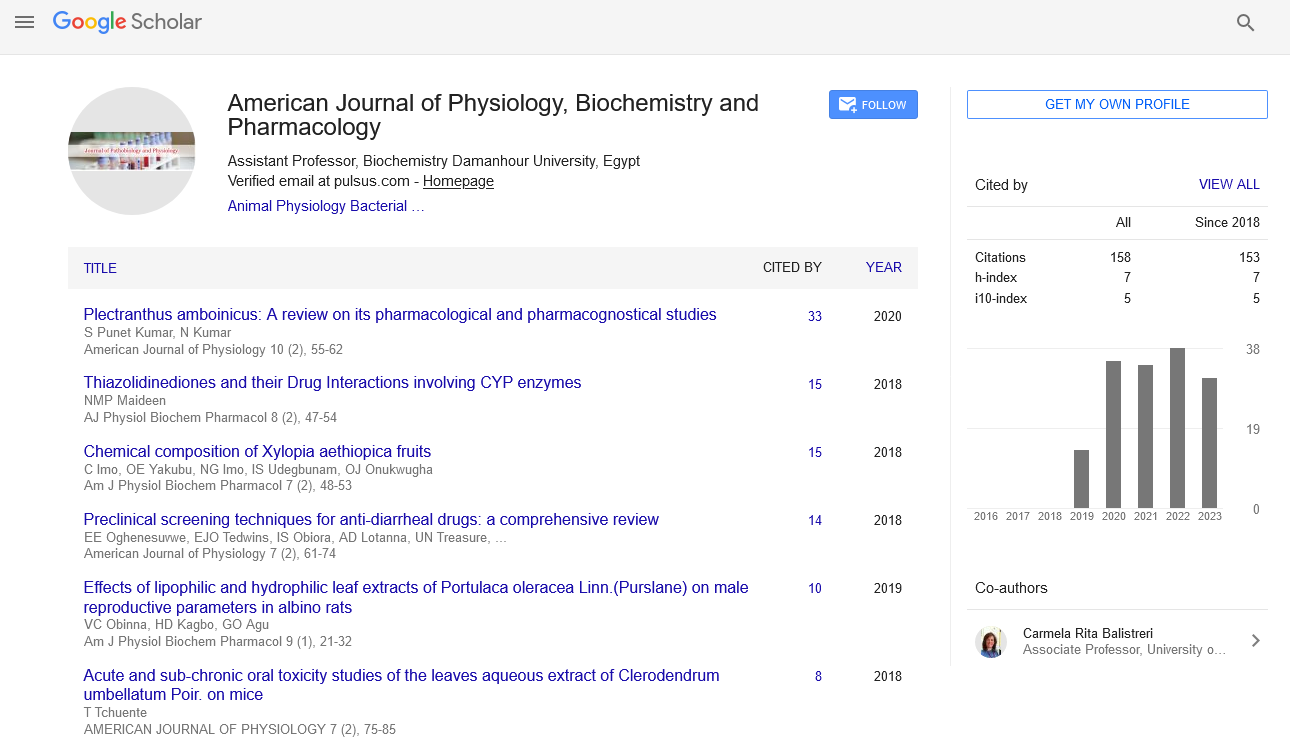Perspective - American Journal of Physiology, Biochemistry and Pharmacology (2023)
Implications of Physical Biochemistry and its Various Methods
Michael Davis*Michael Davis, Department of Physiology, University of Tubingen, Tubingen, Germany, Email: michaeldavis@gmail.com
Received: 04-Jan-2023, Manuscript No. AJPBP-23-88824; Editor assigned: 06-Jan-2023, Pre QC No. AJPBP-23-88824 (PQ); Reviewed: 23-Jan-2023, QC No. AJPBP-23-88824; Revised: 30-Jan-2023, Manuscript No. AJPBP-23-88824 (R); Published: 06-Feb-2023
Description
Biochemistry integrates biology and chemistry and also drives the development of science and medicine in industries by including medicines, forensics, and nutrition. By studying chemical reactions at the molecular level using biochemistry, one can gain a better understanding of their nature and identify novel applications for them. Understanding the chemical applications that allow biological molecules to give rise to cellular interactions and processes within living cells is the main focus of biochemistry, which has significant implications for understanding tissues and organs as well as the structure and function of organisms. The study of the molecular mechanisms underlying biological events is known as molecular biology, and it is closely related to the field of biochemistry.
The methods are used to investigate the physical chemistry of biomolecules are all covered under the field of physical biochemistry. It also covers mathematical methods for modelling biological systems and analysing biochemical reactions. It sheds light on how macromolecules are built and how chemical structure affects a biological substance’s physical characteristics. It involves the investigation of biological systems using physics, physical chemistry, and methods. It uses a variety of physical chemistry methods, including hydrodynamics, X-ray crystallography, spectroscopy, electrophoresis, and chromatography.
Hydrodynamics
The study and description of fluids in motion are central to the field of hydrodynamics. The emphasis is mostly on teaching the laws of conservation of mass, energy, and momentum. Fluids in motion have kinetic energy. Potential energy (pressure, height) can be created from this energy and vice versa.
X-ray crystallography
The experimental science known as X-ray crystallography employs incident X-ray beams to diffract into numerous distinct directions in order to identify the atomic and molecular structure of crystals. An image of the density of electrons within the crystal can be created in three dimensions by measuring the angles and intensities of these diffracted beams. The mean orientations of the atoms in the crystal, their chemical bonds, their crystallographic disorder, and several other details can all be inferred from this electron density.
Spectroscopy
The study of spectroscopy involves measuring and analysing the electromagnetic spectra that emerge from the interaction of electromagnetic radiation with matter as a function of the radiation’s wavelength or frequency. Radiative energy can also include sound waves, matter waves, and gravitational waves, which have recently been connected to a spectral signature in the context of the Laser Interferometer Gravitational- Wave Observatory.
Electrophoresis
A laboratory procedure called electrophoresis is used to divide DNA, RNA, or protein molecules according to their size and electrical charge. The molecules are moved by an electric current through a gel or other matrix. The principle behind electrophoresis is the observation that the majority of biomolecules exist as electrically charged particles with ionizable functional groups. A solution containing biomolecules will have either positively or negatively charged ions depending on the pH.
Chromatography
Chromatography is an analytical method frequently used to separate a chemical mixture into its individual components, by allowing for in-depth analysis of each component. Chromatography can be used to read the contents of the mixture by feeding its output into a detector. Additionally, it can be employed as a purification method to separate a mixture’s constituent parts for use in other operations or studies.
Physical chemistry is concerned with interactions and transformations of materials. Unlike other branches, it deals with the principles of physics underlying all chemical interactions (e.g., gas laws), seeking to measure, correlate, and explain the quantitative aspects of reactions.
Copyright: © 2023 The Authors. This is an open access article under the terms of the Creative Commons Attribution Non-Commercial ShareAlike 4.0 (https://creativecommons.org/licenses/by-nc-sa/4.0/). This is an open access article distributed under the terms of the Creative Commons Attribution License, which permits unrestricted use, distribution, and reproduction in any medium, provided the original work is properly cited.






